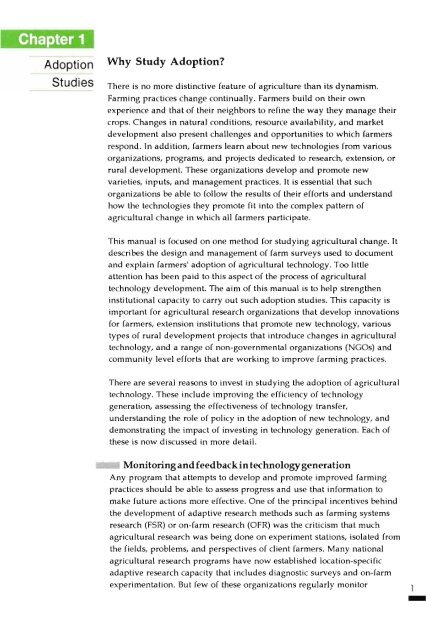The Adoption of Agricultural Technology - Food Security Group
The Adoption of Agricultural Technology - Food Security Group
The Adoption of Agricultural Technology - Food Security Group
Create successful ePaper yourself
Turn your PDF publications into a flip-book with our unique Google optimized e-Paper software.
I Chapter 1<strong>Adoption</strong>StudiesWhy Study <strong>Adoption</strong>?<strong>The</strong>re is no more distinctive feature <strong>of</strong> agriculture than its dynamism.Farming practices change continually. Farmers build on their ownexperience and that <strong>of</strong> their neighbors to refine the way they manage theircrops. Changes in natural conditions, resource availability, and marketdevelopment also present challenges and opportunities to which farmersrespond. In addition, farmers learn about new technologies from variousorganizations, programs, and projects dedicated to research, extension, orrural development. <strong>The</strong>se organizations develop and promote newvarieties, inputs, and management practices. It is essential that suchorganizations be able to follow the results <strong>of</strong> their efforts and understandhow the technologies they promote fit into the complex pattern <strong>of</strong>agricultural change in which all farmers participate.This manual is focused on one method for studying agricultural change. Itdescribes the design and management <strong>of</strong> farm surveys used to documentand explain farmers' adoption <strong>of</strong> agricultural technology. Too littleattention has been paid to this aspect <strong>of</strong> the process <strong>of</strong> agriculturaltechnology development. <strong>The</strong> aim <strong>of</strong> this manual is to help strengtheninstitutional capacity to carry out such adoption studies. This capacity isimportant for agricultural research organizations that develop innovationsfor farmers, extension institutions that promote new technology, varioustypes <strong>of</strong> rural development projects that introduce changes in agriculturaltechnology, and a range <strong>of</strong> non-governmental organizations (NGOs) andcommunity level efforts that are working to improve farming practices.<strong>The</strong>re are several reasons to invest in studying the adoption <strong>of</strong> agriculturaltechnology. <strong>The</strong>se include improving the effiCiency <strong>of</strong> technologygeneration, assessing the effectiveness <strong>of</strong> technology transfer,understanding the role <strong>of</strong> policy in the adoption <strong>of</strong> new technology, anddemonstrating the impact <strong>of</strong> investing in technology generation. Each <strong>of</strong>these is now discussed in more detail.MonitoringandfeedbackintechnologygenerationAny program that attempts to develop and promote improved farmingpractices should be able to assess progress and use that information tomake future actions more effective. One <strong>of</strong> the prinCipal incentives behindthe development <strong>of</strong> adaptive research methods such as farming systemsresearch (FSR) or on-farm research (OFR) was the criticism that muchagricultural research was being done on experiment stations, isolated fromthe fields, problems, and perspectives <strong>of</strong> client farmers. Many nationalagricultural research programs have now established location-specificadaptive research capacity that includes diagnostic surveys and on-farmexperimentation. But few <strong>of</strong> these organizations regularly monitor 1-



